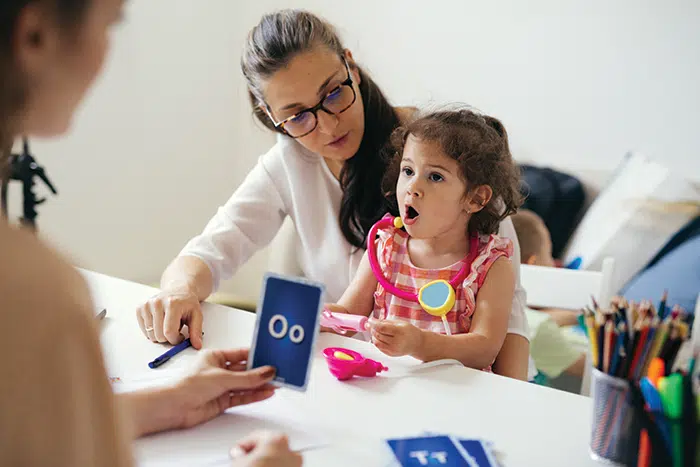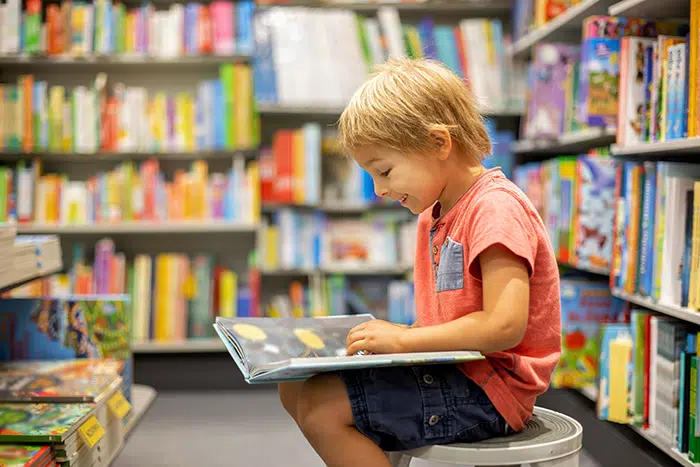
This blog was originally published on September 14, 2023, and was updated on March 1, 20205, with new information. Teaching letter recognition in preschool is a fundamental skill in early childhood education. By making letter recognition engaging and enjoyable through games and activities, you can nurture a child’s love for learning and language.
Let’s explore the significance of letter recognition, its role in phonics, when to start teaching it, its benefits, best teaching methods, progression order, fun games and activities, its connection to letter sound recognition, assessing progress and more!
What Is Letter Recognition and Why Is It Important?
Letter recognition is the ability to identify and differentiate between letters of the alphabet, both in uppercase and lowercase forms. This skill forms the foundation for reading and writing, making it crucial for a child’s early literacy development. Here’s why it matters:
Prepares for Reading: Letter recognition is a prerequisite for reading. Children need to know the letters and their corresponding sounds to decode words.
Enhances Writing Skills: To write, children must recognize and reproduce letters. Letter recognition aids in developing fine motor skills necessary for writing.
Builds Vocabulary: Knowing letters facilitates vocabulary acquisition, as children can associate letters with words and their meanings.
Fosters Cognitive Development: Recognizing letters involves memory, visual discrimination, and pattern recognition, which are all cognitive skills that benefit a child’s overall development.
Is Letter Recognition Part of Phonics?
Yes, letter recognition is a fundamental component of phonics instruction! Phonics focuses on the relationship between letters and sounds. Letter recognition skills form the basis for understanding how letters and sounds work together, paving the way for reading and spelling.
When Does Letter Recognition Start?
Letter recognition typically begins around the age of 2 to 3, although this can vary from child to child. It’s crucial to start teaching it when a child shows interest and readiness. Signs of readiness include an eagerness to engage with books, scribbling and attempting to draw letters or shapes.
Letter Recognition Benefits

Teaching letter recognition to preschoolers offers numerous benefits, including setting the stage for reading and writing skills. Having this skill also enhances a child’s ability to express thoughts and ideas and proficiency in letter recognition correlates with improved academic performance.
And perhaps the biggest benefit is building confidence! Success in recognizing letters boosts a child’s self-esteem and motivation to learn.
The Best Way to Teach Letter Recognition to Preschoolers
Effective teaching methods are essential for successful letter recognition. Let’s take a look at the necessary steps:
Start with Names: Begin by teaching the child the letters in his or her name. This creates a personal connection.
Multisensory Approach: Engage multiple senses by using tactile materials like magnetic letters, sandpaper letters and alphabet puzzles.
Repetition and Reinforcement: Practice is key. Repeat letter recognition activities regularly.
Use Play: Incorporate play into learning. Sing alphabet songs, play letter scavenger hunts and encourage letter-related arts and crafts.
Consider separating letters that are visually confusing. If a preschooler struggles with the letters G and O, don’t teach them at the same time. Once letters have been learned in isolation, provide sorting activities for additional comparison and practice.
The Best Order to Teach Letter Recognition

While there’s no strict order, many educators follow these general guidelines:
Teach Uppercase and Lowercase Together: Present both forms simultaneously to avoid confusion.
Start with Familiar Letters: Teach the letters that appear in the child’s name first.
Group Similar Letters: Introduce letters with similar shapes or sounds together (such as c and o, m and n).
Progress Gradually: Gradually introduce more challenging letters.
Fun Ways to Teach Letter Recognition
Make learning fun with these letter recognition games:
Alphabet Bingo: Play bingo with letter cards.
Letter Puzzles: Use alphabet puzzles to build letter recognition.
Letter Hunt: Go on a letter scavenger hunt indoors or outdoors.
Alphabet Books: Read alphabet books with colorful illustrations.
And check out these ideas for letter recognition learning games from Reading Rockets: Make letter sounds and ask children to draw the matching letters in cornmeal or sand. Take egg cartons and put a paper letter in each slot until all the letters of the alphabet are in order. Say letter sounds and ask children to pick out the letters that match those sounds.
Letter Sound Recognition
Letter sound recognition is closely related to letter recognition. Once children recognize letters, they can start associating them with their sounds. Phonics instruction often follows letter recognition to teach reading.
Connect letter sounds to familiar symbols, suggests the Begin Learning Team. For example, if you want to start with the letter T, consider printing out pictures of things that start with T such as trucks and tigers. Let each child choose which pictures to use, then help them create their very own alphabet book with those images.
Assessing Letter Recognition Progress
Monitor progress by observing your child’s ability to:
Identify Letters: Can they point to or name letters correctly?
Write Letters: Are they able to write some letters independently?
Match Letters to Sounds: Can they associate letters with their corresponding sounds?
Apply Knowledge: Do they use letter recognition skills when attempting to read or write?
How Procare Can Help!
Letter recognition is a critical milestone in a child’s early literacy journey. By starting at the right age and using effective teaching methods, educators in your child care center can lay a strong foundation for reading, writing and overall academic success.
Helping teachers carry out such an important topic for young learners is essential to help them manage their stress. The 2025 Procare Solutions Child Care Business Report found that 47.8% of centers
are reporting burnout and concerns of staff well-being.
Procare Early Learning powered by Learning Beyond Paper is an all-digital early childhood curriculum specifically designed to meet the unique needs of educating children from infancy through pre-kindergarten.
The curriculum is embedded into Procare, making it easier and less time-consuming for busy teachers and administrators to provide high-quality education.
With Procare Early Learning powered by Learning Beyond Paper, child care centers can:
- Equip teachers with state-of-the-art online curriculum at their fingertips
- Dramatically reduce the amount of time spent on lesson planning each week
- Offer children a high-quality, developmentally appropriate curriculum
- Save money with this cost-efficient solution that’s integrated with Procare
This curriculum can be used in ALL child care center classrooms, with 52 weeks of lesson plans and more than 4,000 daily activities for infants, toddlers, preschoolers and pre-kindergarteners. Learning areas include STEAM, language and literacy, physical development, cognitive, music and movement as well as interactive reading. Plus, teachers get tips and tools.
Procare is the only solution that can deliver the entire early childhood education ecosystem — lesson planning, lesson delivery within the classroom as well as assessment and parent engagement. Being able to do all of these with one platform simplifies classroom management and planning!
How much time and money could your child care center save using a digital curriculum designed for young learners? Enter your number of staff, number of students and type of program into our online calculator to see your potential time and money savings!




